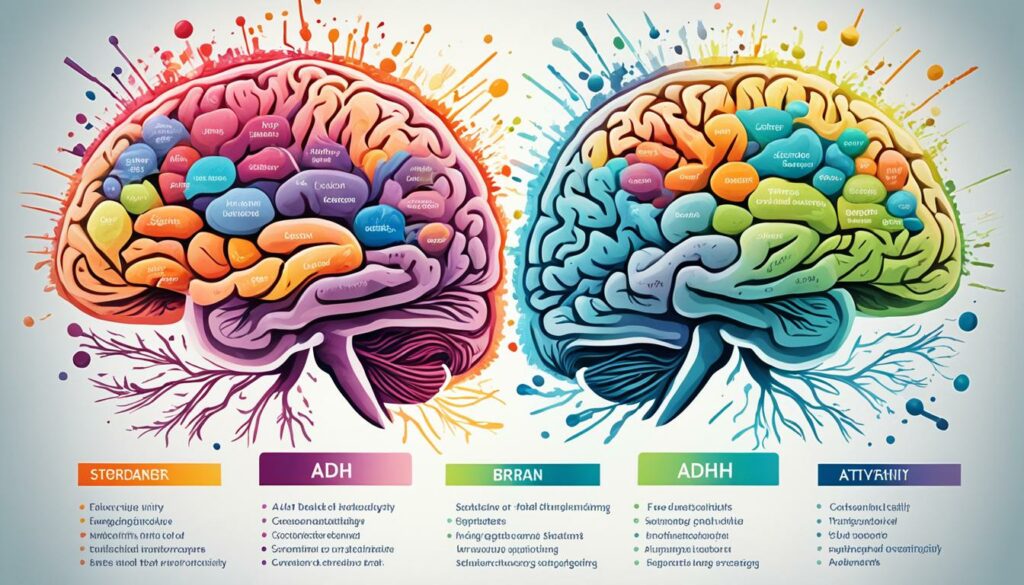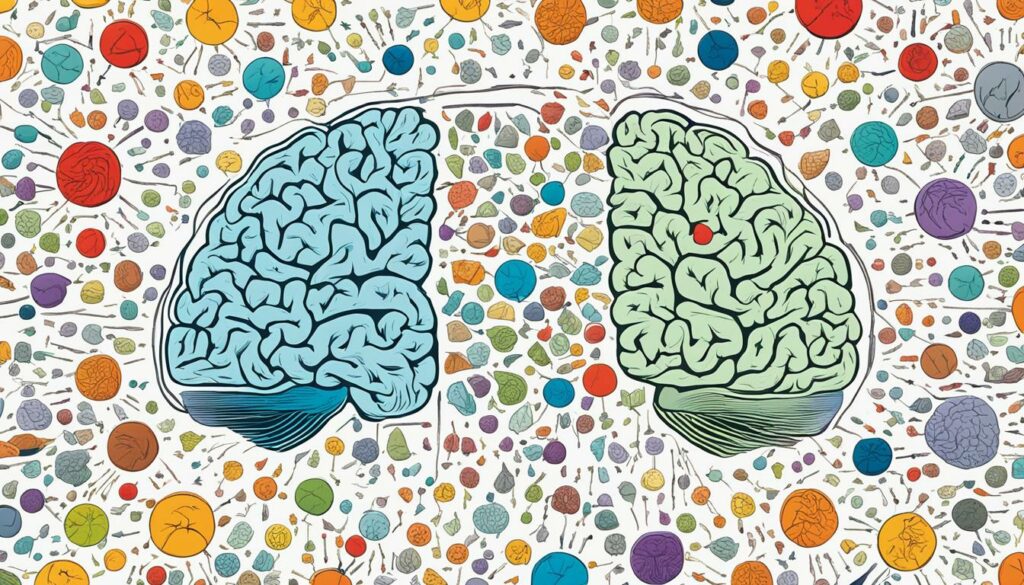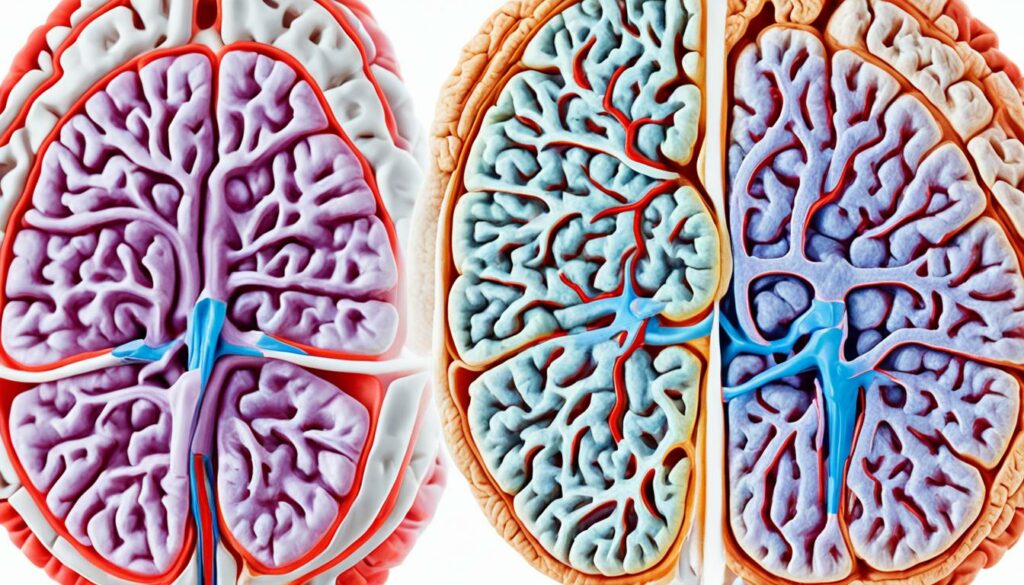Did you know that approximately 8% of children and 2-4% of adults worldwide are affected by Attention Deficit Hyperactivity Disorder (ADHD)? This neurodevelopmental condition not only impacts individuals’ daily lives but also brings forth unique challenges and functionalities in the ADHD brain.
Key Takeaways:
- ADHD affects approximately 8% of children and 2-4% of adults worldwide.
- People with ADHD face unique challenges and functionalities in their brain.
- The ADHD brain differs in terms of structure, function, and development compared to neurotypical individuals.
- Understanding these differences is essential for effective treatment and support.
- ADHD individuals can harness their strengths, such as creativity and high energy levels, to improve their quality of life.
Understanding the Differences in ADHD Brain Structure
Research has shown that the structure of the ADHD brain differs from that of individuals without ADHD. One significant difference is in brain size, particularly in the frontal cortex. Studies have revealed that people with ADHD may have smaller brain sizes compared to their neurotypical counterparts.
This discrepancy in brain size can have implications for cognitive functions such as attention and impulse control. The frontal cortex plays a crucial role in regulating these functions, and its smaller size in individuals with ADHD may contribute to challenges in these areas.
Additionally, the maturation of neuronal circuits in the ADHD brain can be delayed. Neuronal circuits are the pathways through which information is transmitted in the brain. When these circuits are not fully developed, it can lead to difficulties in cognitive and behavioral functioning.
Understanding the differences in ADHD brain structure is vital for comprehending the challenges faced by individuals with this condition. By gaining insight into these differences, we can develop tailored strategies and interventions to support their cognitive and behavioral needs.
Image provided for illustrative purposes only. Alt attribute: ADHD brain structure
Exploring ADHD Brain Function
ADHD can have a profound impact on brain functioning, resulting in a range of cognitive, behavioral, and motivational challenges. Individuals with ADHD often experience abnormalities in brain activity, the regulation of moods and emotions, and communication between different brain areas. These differences can disrupt cognitive functioning and the balance of brain networks, leading to difficulties in focus, movement, and reward processing.
Studies have shown that the ADHD brain exhibits altered patterns of brain activity compared to neurotypical individuals. Such differences in brain activity have been observed in regions responsible for attention, impulse control, and executive functions. The imbalance in brain networks, including the default attention network, can further contribute to the cognitive and behavioral difficulties experienced by individuals with ADHD.
The Default Attention Network and ADHD
The default attention network plays a crucial role in maintaining focus and internal thought processes. In individuals with ADHD, this network may exhibit irregularities, affecting their ability to sustain attention and engage in goal-directed behavior. Consequently, individuals with ADHD may struggle with tasks that require continuous focus, and they may find it challenging to filter out distractions.
Research has shown that individuals with ADHD have decreased connectivity within the default attention network, which can impact cognitive performance and contribute to symptoms such as inattention and impulsivity.
In addition to altered brain activity and network connectivity, individuals with ADHD may also experience difficulties in regulating their emotions. This can manifest as mood swings, heightened sensitivity, and difficulty managing stress. The interplay between brain regions responsible for emotional regulation and cognitive functioning may be disrupted, further exacerbating the challenges faced by individuals with ADHD.
Understanding the intricate relationship between brain function, network connectivity, and cognitive processes in ADHD is crucial for developing effective treatment strategies. By targeting specific brain regions and networks affected by ADHD, interventions can be designed to improve cognitive functioning, enhance attentional control, and optimize overall brain function.

| ADHD Brain Function Challenges | Impact on Cognitive Functioning | Effect on Behavior |
|---|---|---|
| Irregular brain activity and network connectivity | Difficulties in attention, focus, and executive functions | Inattention, impulsivity, and difficulty regulating behavior |
| Disruptions in emotional regulation | Heightened sensitivity and mood swings | Difficulty managing stress and emotions |
ADHD Brain Development and Imaging Studies
The development of the ADHD brain differs from that of neurotypical individuals, as evidenced by various imaging studies. These studies utilize advanced tools such as MRI and X-rays to explore the structural and functional aspects of the ADHD brain.
Structural Differences
Imaging studies have revealed that individuals with ADHD exhibit structural differences in their brains compared to neurotypical individuals. These differences can be observed in brain regions associated with attention, impulse control, and executive functions.

| Structural Differences in the ADHD Brain | Neurotypical Brain | ADHD Brain |
|---|---|---|
| Smaller frontal cortex | Regular size | Reduced size |
| Altered neurotransmitter levels | Normal levels | Imbalance in neurotransmitters |
Functional Connectivity
Functional connectivity refers to the synchronized activity between different brain regions while performing specific tasks or during resting state. Imaging studies have found disruptions in functional connectivity within the brains of individuals with ADHD.
“The imbalances in brain network structure (structural connectivity) and activity (functional connectivity) contribute to the challenges experienced by individuals with ADHD.”
These disruptions in functional connectivity impact various cognitive functions and behavioral processes, including attention, impulse control, and emotional regulation.
Brain Network Imbalances
The brain is composed of intricate networks that allow for efficient communication and information processing. In individuals with ADHD, imaging studies have revealed imbalances in brain network structure and activity.
Specifically, the default mode network, responsible for self-reflection and external stimulus filtering, may show altered connectivity in individuals with ADHD. This can lead to difficulties in sustaining attention and regulating responses to external stimuli.
The table below summarizes the imbalances observed in brain network structure and activity in individuals with ADHD:
| Imbalances in Brain Network Structure and Activity | Contributions to ADHD Challenges |
|---|---|
| Altered default mode network connectivity | Inability to sustain attention and regulate responses |
| Disrupted communication between brain regions | Impaired integration of information and cognitive functions |
Through the use of advanced imaging techniques, researchers have gained valuable insights into the development of the ADHD brain. These findings help us better understand the challenges faced by individuals with ADHD and pave the way for targeted interventions and therapies.
ADHD and Executive Functioning Skills
ADHD can greatly impact executive functioning skills, which are essential for everyday tasks and goal-directed behaviors. Executive functions encompass a wide range of cognitive processes that enable individuals to regulate their thoughts, emotions, and actions effectively. Let’s explore how ADHD affects various executive functioning skills:
Attention
Individuals with ADHD often struggle with sustaining attention and staying focused on tasks or activities. They may be easily distracted by external stimuli or have difficulty filtering out irrelevant information.
Impulsivity
Impulsivity is a hallmark feature of ADHD. People with ADHD may act on their impulses without considering the consequences, leading to impulsive behaviors and decision-making.
Hyperactivity
Hyperactivity is characterized by excessive physical or mental restlessness. Individuals with ADHD may have difficulty sitting still, often feeling a constant need to move or engage in excessive talking.
Organization and Planning
ADHD can hinder individuals’ abilities to organize their thoughts, belongings, and time effectively. Planning tasks and following through with them can be challenging, resulting in difficulties with managing daily responsibilities.
Memory
ADHD can affect different aspects of memory, including working memory and long-term memory. Working memory refers to the ability to hold and manipulate information in one’s mind, which can be problematic for individuals with ADHD.
Decision-Making
Due to impulsivity and difficulties in evaluating the potential outcomes of decisions, individuals with ADHD may struggle with decision-making processes. They may have a tendency to make hasty decisions without thoroughly considering the pros and cons.
Social Skills
ADHD can impact social interactions and communication skills. Individuals with ADHD may have challenges reading social cues, maintaining conversations, and regulating their behavior appropriately in social situations.
Learning from Past Mistakes
Individuals with ADHD may struggle to learn from their past mistakes, as difficulties in executive functioning can interfere with the ability to reflect on consequences and adjust future behaviors accordingly.
These executive functioning challenges associated with ADHD can significantly impact various areas of life, including academics, work performance, relationships, and daily functioning. Recognizing and addressing these difficulties is crucial to support individuals with ADHD and help them develop effective strategies to manage and overcome these challenges.

“Executive functioning difficulties in ADHD can make even the simplest tasks a significant challenge.” – Dr. Sarah Johnson, Neuropsychologist
| Executive Functioning Skills | Impact of ADHD |
|---|---|
| Attention | Difficulty sustaining attention and easily getting distracted. |
| Impulsivity | Tendency to act on impulses without considering consequences. |
| Hyperactivity | Restlessness and constant need for movement or talking. |
| Organization and Planning | Challenges in organizing thoughts, belongings, and time effectively. |
| Memory | Difficulties with working memory and retaining information. |
| Decision-Making | Tendency to make hasty decisions without evaluating potential outcomes. |
| Social Skills | Difficulties in reading social cues and regulating behavior in social situations. |
| Learning from Past Mistakes | Challenges in reflecting on consequences and adjusting future behaviors. |
ADHD Brain Differences and Diagnosis
Diagnosing ADHD involves a comprehensive evaluation of a person’s symptoms and behaviors. Healthcare professionals use a combination of methods to accurately diagnose ADHD, including:
- Behavior Checklists: These checklists involve gathering information from parents, teachers, and other caregivers about the individual’s behavior patterns and symptoms. These questionnaires help in understanding the presence and severity of ADHD symptoms, such as inattention, hyperactivity, and impulsivity.
- Tests and Assessments: Various tests, such as cognitive tests and tests for specific aspects of executive functioning, can provide quantitative data on a person’s cognitive abilities and attention skills. Conducting such tests is useful in identifying deficits and challenges associated with ADHD.
- Interviews: Clinicians conduct interviews with the person being evaluated and other individuals close to them, such as parents, family members, and teachers. These interviews help gather additional information about the individual’s behavior, daily functioning, and potential ADHD symptoms.
- Observations: Teachers and family members submit detailed observations about the individual’s behavior and ADHD symptoms in different settings, such as school and home. These observations assist in assessing the consistency and impact of symptoms across various environments.
In addition to these traditional diagnostic methods, brain imaging scans can provide valuable insights into the structural and functional differences associated with ADHD.
“Brain scans, such as functional Magnetic Resonance Imaging (MRI), Single-Photon Emission Computed Tomography (SPECT), and Positron Emission Tomography (PET) scans, play a significant role in ADHD diagnosis. These scans allow us to visualize the brain’s activity, blood flow, and connectivity, helping identify ADHD-related structural and functional differences.”
For example, functional MRI (fMRI) scans can show areas of the brain that are activated or deactivated during specific tasks, highlighting potential dysfunctions in the brain’s networks. These scans provide a more comprehensive understanding of the neural basis of ADHD and its impact on cognitive functioning.
One promising diagnostic tool is the Neuropsychiatric EEG-Based Assessment Aid System (NEBA), which measures brainwave patterns. NEBA can assess the ratio of theta and beta waves, which can help differentiate ADHD from other conditions with similar symptoms. However, it is important to note that brain scans alone are not sufficient for diagnosing ADHD. They are used as an additional diagnostic tool to support a comprehensive evaluation.
Overall, the combination of symptom evaluations, cognitive assessments, interviews, observations, and brain imaging scans helps healthcare professionals make an accurate diagnosis of ADHD. Understanding the underlying brain differences is essential for tailoring appropriate treatment and support measures.

Uncovering the Benefits of the ADHD Brain
While ADHD presents numerous challenges, there are also possible benefits associated with the condition. People with ADHD often exhibit strengths such as creativity, outside-the-box thinking, and high energy levels. These strengths can be harnessed and utilized to their advantage in certain situations.
The Strengths of ADHD
ADHD individuals have a unique way of thinking that allows them to see the world from a different perspective. Their creativity knows no bounds, enabling them to come up with innovative solutions and ideas. Whether it’s in art, problem-solving, or brainstorming sessions, individuals with ADHD are often known for their imaginative thinking.
“Having ADHD is like having a turbocharged brain. It may be challenging at times, but the energy and enthusiasm it brings can lead to incredible breakthroughs and accomplishments.” – Dr. Catherine Thompson, Neuroscientist
In addition to their creative abilities, ADHD individuals are often highly energetic, constantly seeking stimulation and engaging in adventurous activities. This energy can be channeled into productive endeavors, making them highly motivated and driven to succeed.
ADHD and Outside-the-Box Thinking
The ADHD brain is wired to think differently, which can be a tremendous asset. These individuals excel at thinking outside the box, finding unconventional solutions to problems that others may not have considered. Their ability to make connections between seemingly unrelated ideas can lead to breakthrough innovations and unique approaches to challenges.
Harnessing the Potential
- Encourage creativity: Provide opportunities for individuals with ADHD to express their creative abilities, whether it’s through art, music, writing, or other forms of expression. Celebrate their unique ideas and encourage them to pursue their passions.
- Provide outlets for energy: Engage ADHD individuals in physical activities or sports to help channel their energy in a positive way. These activities can help improve focus, reduce impulsivity, and increase overall well-being.
- Foster a supportive environment: Create an environment that embraces and appreciates different thinking styles. Encourage collaboration and diversity of thought, allowing ADHD individuals to thrive and contribute their unique perspectives.
By recognizing and harnessing the strengths of individuals with ADHD, we can create a society that values neurodiversity and unlocks the full potential of every individual.
| Strengths of ADHD | Examples |
|---|---|
| Creativity | Unique artistic expressions, innovative problem-solving, imaginative thinking |
| Energy and motivation | Driven to succeed, high energy levels, enthusiasm for new challenges |
| Outside-the-box thinking | Unconventional problem-solving, making unique connections between ideas, thinking beyond traditional boundaries |
Conclusion
Understanding the functionality and challenges of the ADHD brain is crucial for effective treatment and support. People with ADHD experience differences in brain structure, function, and development, which contribute to the symptoms and difficulties they face in daily life.
By addressing these challenges through tailored ADHD treatment plans, we can improve the quality of life and academic performance of individuals with this neurodevelopmental condition. Treatment options such as medication, behavioral therapy, and lifestyle modifications can help manage symptoms and enhance cognitive functioning.
It is also important to recognize and harness the strengths associated with ADHD. Many individuals with ADHD possess notable creativity, out-of-the-box thinking, and high energy levels. By leveraging these strengths, individuals with ADHD can excel in certain situations and thrive in their personal and professional lives.
Overall, with ADHD brain understanding, customized treatment approaches, and a focus on optimizing strengths, we can make significant strides in improving the quality of life for individuals with ADHD and helping them reach their full potential.
